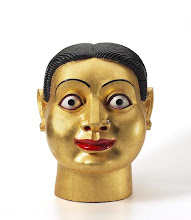Indian cotemporary artists are not new on the scene, but this year we are hearing a lot more about them.
Divia Patel, curator of the Asian Department at the
V&A told me that this buzz is the product of a large amount of international exposure over the last few years, that mainly started in 2006 when a paiting by Indian artist
Tyeb Mehta sold for US$1.7 million at a New York acution. Since then, Indian art has been in all major international fairs --
art dubai,
ARCO --and festivals; and for collectors, it has become the next big thing after China.
In countries where western art parameters are not the norm, there is always a movement that opens the door to contemporary forms, and in India it was the
Progressive Artists group that emerged in 1940.
Again, there are plenty of names to look for (see my slide show)-- from the great masters of contemporary art like Francis NEWTON SOUZA, MF HUSAIN, and Tyeb MEHTA, to the avant garde line such as TV SANTOSH, Nikhil CHOPRA, or Sunoj D-- but maybe the apple of all the collectors' eyes is
Subodh GUPTA, whose work was included in the Venice Biennale, is featured in every Indian art show in the UK and US, and is in the collections of
Francois Pinault and
Larry Gagosian.
(Gupta is also dubbed the Damien Hirst of India, not least because on of his masterpieces is an enormous skull made of stainless steel pans and pots titled
Very Hungry God. Do read his interview in
Art Review--his art is meaningfully connected to India's realities and issues.)
So, where to see Indian art in the UK? The main shows are
And, don't forget to check the galleries (Aicon, Albion, Grosvenor Vadhera)...
